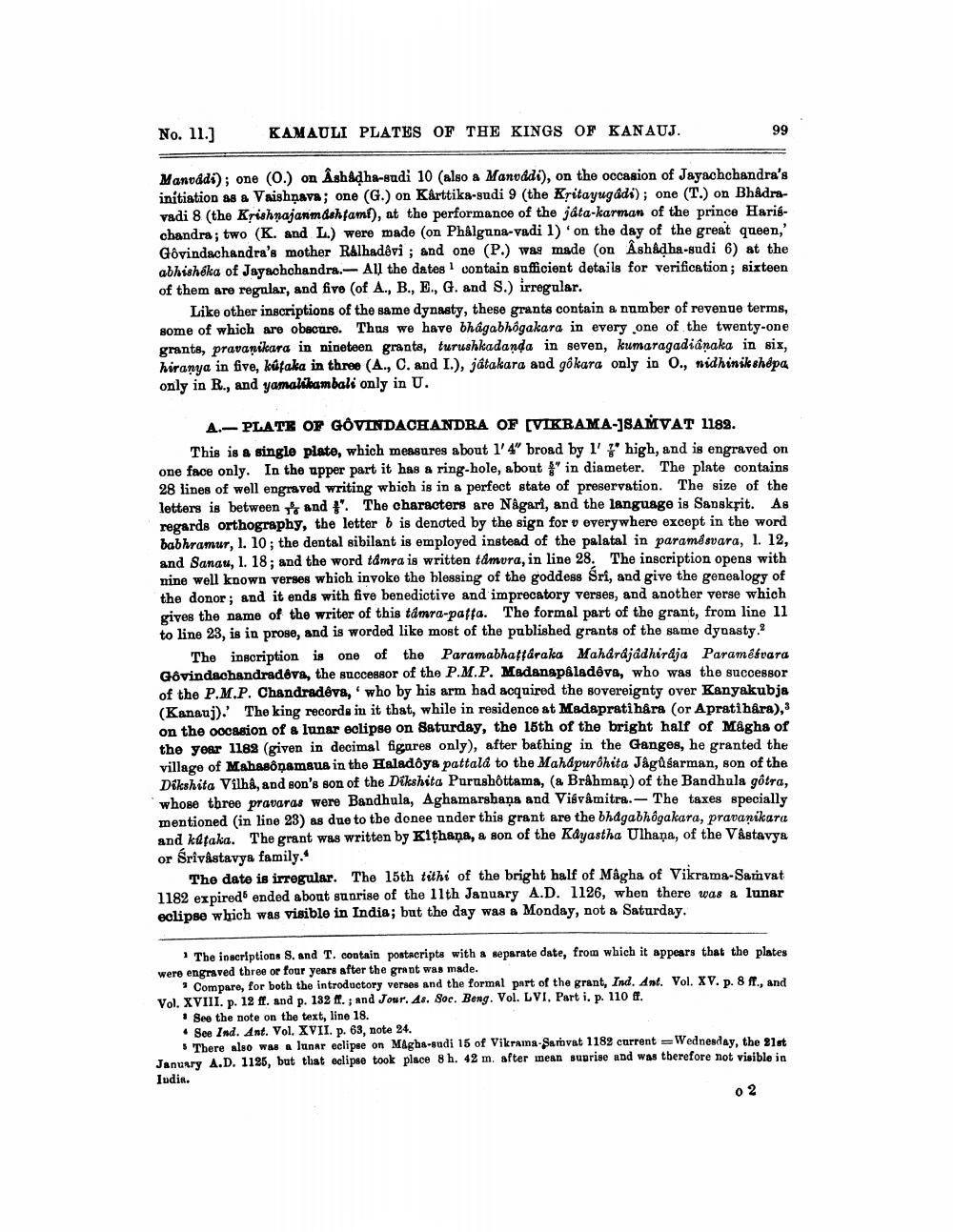________________
No. 11.)
KAMAULI PLATES OF THE KINGS OF KANAUJ.
99
Manoddo); one (O.) on Ash&dha-sudi 10 (also a Manoddí), on the occasion of Jayachchandra's initiation as a Vaishnavs; one (G.) on Kårttika-sudi 9 (the Kritayugadi); one (T.) on Bhadravadi 8 (the Krishnajanm dohtami), at the performance of the játa-karman of the prince Harischandra; two (K. and L.) were made (on Phålgana-vadi 1) 'on the day of the great queen,' Gôyindschandra's mother Ralhadêvi ; and one (P.) wag made on Ash&dha-sudi 6) at the abhisheka of Jayachchandra.-- All the dates contain sufficient details for verification; sixteen of them are regular, and five (of A., B., E., G. and s.) irregular.
Like other inscriptions of the same dynasty, these grants contain a number of revenge terms, some of which are obscure. Thus we have bhagabhôgakara in every one of the twenty-one grants, pravanikara in nineteen grants, turushkadanda in seven, kumaragadianaka in six, hiranya in five, kütaka in three (A., C. and I.), játakara and gôkara only in 0., widhinik shepa only in R., and yamalikambali only in U.
A.- PLATE OF GOVINDACHANDRA OF VIKRAMA-18AVAT 1182.
This is a single plate, which measures about 1'4" broad by 1' thigh, and is engraved on one face only. In the upper part it has a ring-hole, about " in diameter. The plate contains 28 lines of well engraved writing which is in a perfect state of preservation. The size of the letters is between and f". The characters are Nagari, and the language is Sanskrit. As regards orthography, the letter b is denoted by the sign for v everywhere except in the word babhramur, 1. 10; the dental sibilant is employed instead of the palatal in paramê svara, 1. 12, and Sanas, 1. 18; and the word támra is written tamura, in line 28. The inscription opens with nine well known verses which invoke the blessing of the goddess Sri, and give the genealogy of the donor; and it ends with five benedictive and imprecatory verses, and another verse which gives the name of the writer of this támra-paffa. The formal part of the grant, from line 11 to line 23, is in prose, and is worded like most of the published grants of the same dynasty
The inscription is one of the Paramabhaffáraka Maharajadhirdja Paramétvara Govindachandradeva, the successor of the P.M.P. Madanapâledêve, who was the successor of the P.M.P. Chandradeva,' who by his arm had acquired the sovereignty over Kanyakubja (Kanauj). The king records in it that, while in residence at Madapratihara (or Apratihara), on the oocasion of & lunar eclipse on Saturday, the 15th of the bright half of Magha of the year 1182 (given in decimal figares only), after bathing in the Ganges, he granted the village of Mahasônamaus in the Haladoya pattala to the Mahapurðhita Jágusarman, son of the Dikshita Vilhê, and son's son of the Dikshita Purushottama, (a Brahman) of the Bandhula gôtra, whose three pravaras were Bandhula, Aghamarshaņa and Visvamitra.- The taxes specially mentioned (in line 23) as due to the donee under this grant are the bhdgabhôgakara, pravanikara and kdtaka. The grant was written by Kithaņa, a son of the Kayastha Ulhana, of the Våstavya or Srivastavya family.“
The date is irregular. The 15th tithi of the bright half of Mágha of Vikrama-Sarvat 1182 expired ended about sunrise of the 11th January A.D. 1126, when there was a lunar eclipse which was visible in India; but the day was a Monday, not a Saturday,
The inscriptions S. and T. contain postacripts with a separate date, from which it appears that the plates were engraved three or four years after the grant was made.
* Compare, for both the introductory verses and the formal part of the grant, Ind. Ant. Vol. XV. p. 8 ff., and Vol. XVIII. p. 12 ff. and p. 132 14.; and Jour. As. Soc. Beng. Vol. LVI, Part i. p. 110 ff.
• See the note on the text, line 18. • See Ind. Ant. Vol. XVII. p. 63, note 24.
There also was a lunar eclipse on Magha-sudi 15 of Vikrama-Samvat 1182 current Wednesday, the 31st January A.D. 1125, but that eclipse took place 8 h. 42 m, after mean suprise and was therefore not visible in Iudin.
02




